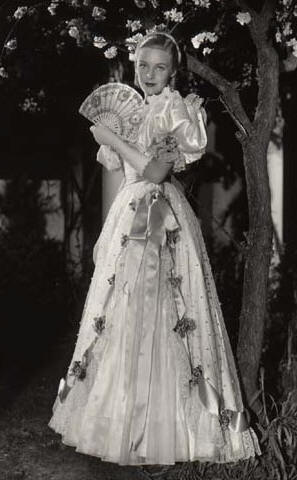

|
| SEARCH |
Madeleine Carroll bio |
| The World Unites For Children |
 |
 Widely
recognized as one of the most beautiful women in films, Carroll's
aristocratic blonde allure and sophisticated style were first glimpsed
by British movie audiences in The Guns of Loos in 1928. Rapidly rising
to stardom in England, she graced such popular films of the early '30s
as Young Woodley, Atlantic, The School for Scandal and I Was A Spy.
Abruptly, she announced plans to retire from films to devote herself to
a private life with her husband, the first of four. Widely
recognized as one of the most beautiful women in films, Carroll's
aristocratic blonde allure and sophisticated style were first glimpsed
by British movie audiences in The Guns of Loos in 1928. Rapidly rising
to stardom in England, she graced such popular films of the early '30s
as Young Woodley, Atlantic, The School for Scandal and I Was A Spy.
Abruptly, she announced plans to retire from films to devote herself to
a private life with her husband, the first of four.MadeleineShe attracted the attention of Alfred Hitchcock and, in 1935, starred as one of the director's earliest prototypical cool, glib, intelligent blondes in The 39 Steps based on the seminal espionage novel by John Buchan. The film became a sensation and with it, so did Carroll. Cited by the New York Times for a performance that was "charming and skillful",[citation needed] Carroll became very much in demand thanks, in part, to director Hitchcock, who later admitted that he worked very hard with her to bring out the vivacious and sexy qualities she possessed offscreen, but which sometimes vanished when cameras rolled.[citation needed] Of Hitchcock's heroines, as exemplified by Carroll, film critic Roger Ebert once wrote that they "reflected the same qualities over and over again: They were blonde. They were icy and remote. They were imprisoned in costumes that subtly combined fashion with fetishism. They mesmerized the men, who often had physical or psychological handicaps."[citation needed] The director wanted to re-team Carroll with her 39 Steps co-star Robert Donat the following year in Secret Agent, a spy thriller based on a work by W. Somerset Maugham. However, Donat's recurring health problems prevented him from accepting the role and, instead, Hitchcock paired Carroll with John Gielgud. Poised for international stardom, Carroll was the first British beauty to be offered a major American film contract; she accepted a lucrative deal with Paramount Pictures. She starred opposite Gary Cooper in the adventure The General Died at Dawn and with Ronald Colman in the 1937 box-office hit The Prisoner of Zenda. She tried a big musical On The Avenue (1937) opposite Dick Powell, but others of her films, including One Night in Lisbon (1941), and My Favorite Blonde (1942) with Bob Hope, were less prestigious. She made her final film for director Otto Preminger, The Fan, adapted from Oscar Wilde's Lady Windermere's Fan, in 1949. For her contribution to the motion picture industry, Madeleine Carroll has a star on the Hollywood Walk of Fame at 6707 Hollywood Blvd. A commemorative monument and plaques were unveiled in her birthplace, West Bromwich, to mark the centenary of her birth. Personal life After her only sister Marguerite was killed in the Blitz, she radically shifted her priorities from acting to instead working in field hospitals as a Red Cross nurse during World War II. She served in the 61st Field Hospital, Bari, Italy in 1944, where many wounded American airmen flying out of air bases around Foggia were hospitalized. She was awarded the Legion d'Honneur for bravery in France. She became a naturalized citizen of the United States in 1943. Madeleine Carroll was married four times: Captain Philip Astley (1931–1940) Sterling Hayden (1942–1946) Andrew Heiskell (1950–1965) Henri Lavorel Madeleine Carroll died on October 2, 1987 from pancreatic cancer in Marbella, Spain aged 81, exactly one week after The Prisoner of Zenda co-star, Mary Astor. She was initially interred in Fuengirola, Málaga, Spain but in 1998 was reburied in the cemetery of Sant Antoni de Calonge in Catalonia, Spain.[2] |
RGHF members, who have been invited to this page, may register RGHF members, who have been invited to this page, may register If a DGE/N/D joins prior to their year, they will have more exposure to Rotary's Global History by their service year. This will be beneficial to all concerned. *Based on paid members, subscribers, Facebook friends, Twitter followers, mobile app users, History Library users, web pages, and articles about Rotary's Global History RGHF Home | Disclaimer | Privacy | Usage Agreement | RGHF on Facebook | Subscribe | Join RGHF | |